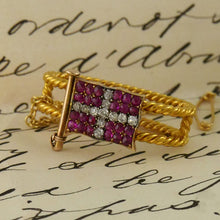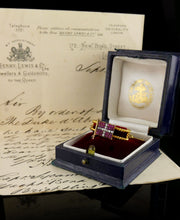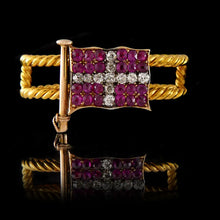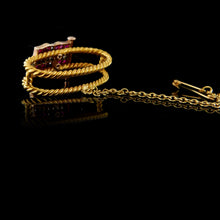Big Class Yacht Racing - Italian Royal Presentation Scarf Slide, 1898
Adding product to your cart
15mm x 30mm
Gold, diamonds and rubies. Formed from twin rope twist bands applied with a rendering of HRH the Duke of the Abruzzi’s private signal (yacht owner’s identifying flag). Accompanied by an original manuscript letter from the Bond Street jeweller Henry Lewis to Captain Edward Sycamore, the skipper of the duke’s racing yacht Bona, requesting the recipient’s acknowledgement of the slide’s safe arrival.
The present scarf slide was gifted as a token of gratitude by HRH Duke of the Abruzzi, for the international prestige achieved through Big Class yacht racing over two seasons by the leading British yachtsman of the day Edward ‘Syc’ Sycamore. The Duke, though a sportsman and explorer of international repute, took no active part in yachting only wanting his crew to win victories under the flag of the Royal House of Savoy.
Read more
Believing Italy should be represented at the highest level, the Duke decided to join yachting’s Big Class where the Kaiser and Prince of Wales competed. Like them he turned to the Clydeside designer G.L. Watson to design his yacht and the resultant cutter Bona was highly successful. Bona dominated her class with Sycamore at the helm and by the end of the 1897 season had won 32 firsts and 7 seconds in 51 starts and three Queen’s Cups. The Duke thanked Sycamore and the crew with a banquet in London where he announced that having achieved all that he could hope for in yachting, he would now seek to reach the North Pole.
Prince Luigi Amedeo of Savoy, Duke of the Abruzzi (1873-1933) was the son of King Amadeo of Spain. Following his father’s abdication, he went to Italy where his grandfather was King Vittorio Emanuele II. Created Duke of the Abruzzi, Luigi was a trained mountaineer and became famous for his many expeditions. These included pioneering adventures in the Alps, the Himalayas and Canada, culminating in 1898 with Italy’s first polar expedition, in which he lost two fingers to frost bite. He later undertook expeditions to Africa (1906), and the Himalayas (1909). He served in the Italian Navy during the First World War, commanding the Adriatic Fleet (1914-1917).

Captain Edward Isaac Sycamore (1857-1930) was famed for his sarcasm and was widely regarded as the leading British yacht skipper of his generation during the period 1890 to 1929. He went to sea as a boy working in a fishing boat. After several seasons he moved to yachting in 1875, working initially for the Marquess of Ailsa on voyages to the West Indies and Mediterranean. His first command was the Amberwitch in 1884. Following early successes in the 2½ rater The Babe, he rose rapidly to the top of his profession, skippering the 40-raters Corsair and Vendetta and the 1895 Americas Cup Challenger Valkyrie III. During the First World War he was commissioned in the RNVR and commanded motor launches operating from seaplane bases in Cornwall and Hampshire. He consequently became captain in the RAF on its formation in 1918. After the war the resumed his yacht racing career. He died at his home in Brighlingsea, Essex after breaking several ribs sustained while racing Sir Thomas Lipton’s Shamrock IV.













